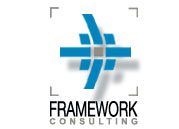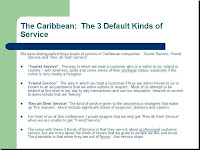FirstCuts 
A Framework Consulting Online eZine
High-Stake Interventions — New Ideas Issue 8 February 15, 2007 Delegating in Caribbean Companies |
|
Editorial
This week’s issue is one that I had to break up into at least two parts, due to its length. This is the first time that I have had to do this, and I think that wherever it makes sense I will try to break up lengthy issues. I am aware of the studies that show that it is easier to read from paper than it is onscreen, and that the writing and spacing needs to be quite different. At the same time, I have a hunch that my average reader is more used to the British than American style of Next month at this time the Cricket World Cup will be underway across the region. It will be the single largest undertaking for our region, and the most important collaborative effort by our relatively small countries. I am hoping that it benefits all our people, as intended. Time to start to Rally Roun’ the West Indies… now and forever! Until next month, Francis |
|
Delegating in Caribbean Companies
In Caribbean companies, and especially in growing start-ups, executives often complain that they cannot find good people to work for them. In our work at Framework, we have found that executives, in particular, have an acutely difficult time filling positions that they themselves once held. They look for professionals with the best credentials, thinking that the new hire’s education should help them to do a job that others before them had to learn on their own. They bring them on board, give them all that they need, including a substantial salary. Success seems to be a “sure thing.” That is, until the new hire shows a lack of “basic common sense.” That is exactly how executives put it to me when they complain that they cannot fill key positions reporting to them in the corporate hierarchy. The star they hired appears not to be a star at all. According to the executive, in a series of critical moments, the new appointee demonstrates an appalling lack of judgement that leaves the executive distressed, and forces them to swoop in to It leaves them wondering why exactly they are paying such a tremendous salary, and how it is that they, themselves, could have learned the job armed with less training, help and pay. Unfortunately, the end-result is often disastrous. The new hire fails, and fails again, until they are fired. In some companies, the cycle continues, as a number of people are hired into the same position, only to fail within a matter of months. No-one seems able to succeed. At one Caribbean company, the key position of VP-HR remains unfilled for over ten years. The company has been through a series of incumbents, none of whom stayed for more than a few months. Interestingly, the President actually performed the job capably at one time, and continues to hold the position in his portfolio while the search for a new executive continues. What exactly is lacking? Is the educational background of the new hires inadequate? Or are the expectations too high? Are executives somehow being unfair when they hire replacements in our Our work in the Caribbean has taught us a few lessons in this area: executives do not properly “systematize” their work, they don’t delegate it systematically and they do not establish “Systematizing” Work The chaos of day-to-day Caribbean business life often seems to be enough to force a manager to operate in perpetual crisis mode. While moving from one problem to another, each and every day brings with it unique challenges that require significant energy and ingenuity just to stay above water. In one company we worked with, there is a policy that managers must answer the phone when it rings, and to reinforce the policy there is no provision for voicemail. The result? Highly trained managers with no control over their personal schedule, as the culture of the company is one in which everything stops when the phone rings. In another company that prided itself on being customer-centric, even the CEO would drop everything when a customer had a problem. It had to be solved immediately at all costs, disrupting meetings and any other activity that happened to be underway. Unfortunately, managers who work in these environments learn not to make plans, and instead surrender themselves to whatever might be happening in the moment. Many compensate by coming to work early, leaving late or working on weekends and holidays — when everyone else in the office is hopefully away. Michael Gerber’s book, The eMyth Revisited, offers a brilliant prescription in the form of an insight: the very best managers not only work IN their jobs, they work ON them. In other words, they Better managers take the next step and “systematize” their job function. They have determined that it is not enough for them to be effective, but they also have decided to assure the success of For example, before my first visit to DisneyWorld as an adult several years ago, I happened to buy a book with the title: “How to Enjoy DisneyWorld without Kids.” The book gave a unique Gerber advocates writing a very similar document for each job, and argues that this is exactly what the very best managers do. They document their short-cuts, process descriptions and tips in a way According to him, it is the single most powerful technique that Ray Kroc, the founder of the McDonald’s chain, used to create the world’s first mega-franchise. After buying a single hamburger The result? Today, identical-tasting hamburger and fries are sold from thousands of restaurants worldwide to 54 million people daily. Systematization is a powerful method that is very rarely used in our region’s companies. When it is not done, incoming managers are forced to learn job from scratch, based on little or no basic information, let alone the kind of detailed and nuanced insights that the executive needs to Turnover Documents Turnover documents include all the information that new hires need to be successful. At the very least, they start with a generic kind of job description. At the very best, they are the end-result of a There is no set format to the documents that I have seen and written. They are informal, and meant for immediate application. They are filled with inside knowledge of how things _really_ work — as opposed to how they are supposed to work. In Jamaica this informal knowledge that is critical to success is known as “the runnings”. Here in the Caribbean, it often means the difference between profit and loss. For example, the turnover document written for a VP-HR position could describe how to obtain a work permit for an expatriate professional. It would detail who to contact within the Ministry A well-written document would save the new VP-HR many hours of time and effort. Yet, in the example cited above, it could only be written by the President of the company — the last person to However, when the turnover document is missing a new hire could flounder, and make the kind of mistakes that the President might call “a lack of common-sense.” Make no bones about it — developing a turnover document takes tedious, quiet work with no immediate payoff. Most managers prefer to focus on the job at hand, and the results they have to produce in the next few days. Any improvements are incorporated into new practices on the fly, as the learning shifts to other competencies. As new competencies are mastered, over time the original, primary learning recedes into the subconscious. In most Caribbean companies that we have worked with, the idea of turnover documents is quite foreign. While it is possible to reverse-engineer them from a manager’s experience and memory, the The best method we have used with our clients involves intense interviews that are essential for getting at the aspects of the job that are done without conscious effort. Sometimes, using this In the cases in which a manager leaves the company altogether, turnover documents are impossible to create, requiring an injection of new costs and time in order to bring a new manager up to speed. A Turnover Culture There is no single approach to developing a culture in which systematization is the norm, but the best companies start by engaging their managers in building a long-term future for the These companies clearly describe the rationale behind systematization, and the need for turnover documents. They ask managers to start writing them once they change jobs, and create Managers also learn that they will not be deemed ready for promotion until their turnover documents are in order, and fully updated. There is a natural resistance to writing these documents that we have found in Caribbean companies, however, and it must be dealt with it at some point. The first source of resistance comes from a bureaucratic unwillingness to make self-replacement easy. Managers often try to protect their positions by keeping key information close to their The second source of resistance comes from the fact that the time spent to develop a turnover document has little immediate and practical benefit to the incumbent. The benefit to having them Companies that are able to create cultures whose values surpass this resistance are able to tap into something very powerful: a technique that builds the company from the inside, with all the Summary Presidents and CEO’s, systematization assures the success of the company in the future, and helps to build a true Learning Organization along the way. Gone is the expectation of instant success, as it becomes apparent to the executive that mastering the job is largely a function of how well it was systematized when it was the incumbent’s From the turnover documents, common sense appears to be not so common after all, and executives can clearly see how their subordinate’s success is up to them, and their ability to systematize their jobs. In next month’s Issue: Learn why accountabilities in turnover documents must be gradually delegated to prevent failure, and also why solo entrepreneurs also need to systematize their work. The FirstCuts Bottom Line: Begin to systematize your work now. * What are some of the things you are doing to systematize your work? Let us know at the Framework blog by following this link and leaving us a comment: http://tinyurl.com/26m3u9 Useful Stuff
Tips, Ads and Links Back Issues of FirstCuts can be found at http://tinyurl.com/pw7fa We are on the lookout for possible contributors to FirstCuts. If you are interested, send email to francis@fwconsulting.com to be included in a future mailing. Please send this request along to To manage this newsletter, we use an excellent programme called AWeber that you can explore here:- http://www.aweber.com/?213577 Subscriber Q&A General and Newsletter Subscription Info To subscribe, please send email to firstcuts@aweber.com from the email address that you which to be subscribed from Please feel free to use excerpts from this newsletter as long as you give credit with a link to our page: www.fwconsulting.com FirstCuts © Copyright 2007, Framework Consulting, except where indicated otherwise. All rights reserved worldwide. Reprint only with permission from copyright holder(s). All trademarks are property of their respective owners. All contents provided as is. No express or implied income claims made herein. Your business success is dependent on many factors, including your own abilities. Advertisers are solely responsible for ad content. |
| FirstCuts: An Online Newsletter From Framework Consulting Inc. 954-323-2552 876-880-8653 3389 Sheridan Street #434 Hollywood FL 33021, USA |









